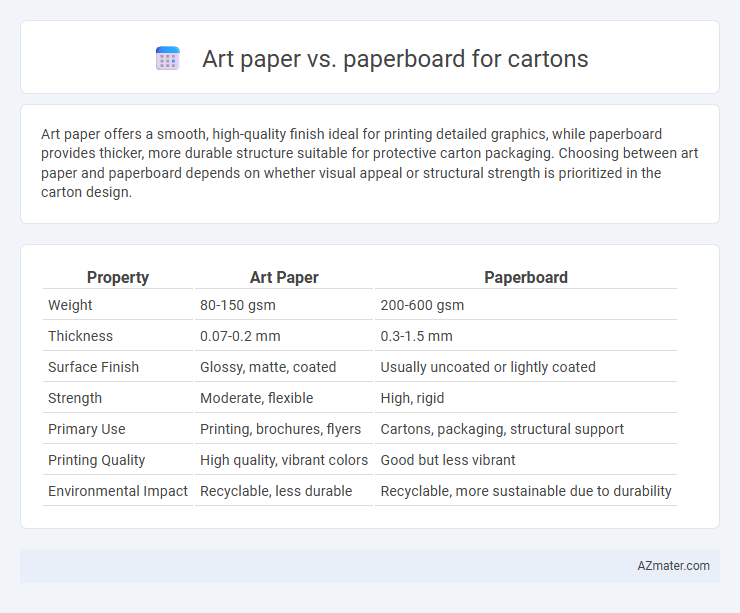Art paper offers a smooth, high-quality finish ideal for printing detailed graphics, while paperboard provides thicker, more durable structure suitable for protective carton packaging. Choosing between art paper and paperboard depends on whether visual appeal or structural strength is prioritized in the carton design.
Table of Comparison
| Property | Art Paper | Paperboard |
|---|---|---|
| Weight | 80-150 gsm | 200-600 gsm |
| Thickness | 0.07-0.2 mm | 0.3-1.5 mm |
| Surface Finish | Glossy, matte, coated | Usually uncoated or lightly coated |
| Strength | Moderate, flexible | High, rigid |
| Primary Use | Printing, brochures, flyers | Cartons, packaging, structural support |
| Printing Quality | High quality, vibrant colors | Good but less vibrant |
| Environmental Impact | Recyclable, less durable | Recyclable, more sustainable due to durability |
Introduction to Art Paper and Paperboard
Art paper offers a smooth, coated surface ideal for high-quality printing and vibrant color reproduction, commonly used in packaging requiring aesthetic appeal. Paperboard, characterized by its thicker and sturdier composition, provides durability and structural integrity for cartons, making it suitable for protective packaging. Understanding the distinctions in weight, texture, and strength between art paper and paperboard is essential for selecting materials that balance visual appeal with functional requirements in carton production.
Key Differences Between Art Paper and Paperboard
Art paper features a smooth, coated surface ideal for high-quality printing and vibrant color reproduction, while paperboard is thicker, sturdier, and primarily used for structural packaging like cartons. The key difference lies in their thickness and durability; art paper ranges from 80 to 250 gsm, suitable for flyers and brochures, whereas paperboard typically exceeds 200 gsm, offering strength and rigidity needed for protective packaging. Additionally, paperboard often includes multiple layers or plies, enhancing its resistance to bending and moisture, a quality less common in single-layer art paper.
Composition and Structure of Art Paper
Art paper consists of a smooth, coated surface layer typically made from wood pulp combined with clay or calcium carbonate fillers, enhancing print quality and brightness. Its structure features multiple thin coats applied to a base paper, resulting in a glossy or matte finish ideal for high-definition printing. In contrast, paperboard is thicker and sturdier, composed of multiple layers of paper fibers compressed together, providing strength and rigidity for carton construction.
Composition and Structure of Paperboard
Art paper is typically coated and smooth, designed for high-quality printing, while paperboard used for cartons is thicker and more rigid, often composed of multiple layers. The structure of paperboard includes a solid fiberboard core sandwiched between linerboards, providing enhanced strength and durability compared to single-ply art paper. This multilayered composition allows paperboard to support higher weight and resist bending, making it ideal for packaging applications.
Printing Quality: Art Paper vs Paperboard
Art paper offers a smoother surface with a high gloss or matte finish, enhancing color vibrancy and detail sharpness in printing, making it ideal for premium packaging visuals. Paperboard, being thicker and more rigid, may absorb ink unevenly, resulting in less precise images but provides better structural support for cartons. For cartons requiring both high-quality prints and durability, selecting art paper coated paperboard can optimize printing quality without compromising strength.
Durability and Strength Comparison
Art paper offers a smooth surface ideal for high-quality printing but generally lacks the thickness and rigidity required for heavy-duty packaging, making it less durable under stress. Paperboard, produced in thicker layers with denser fibers, provides superior strength and resistance to bending, making it more suitable for cartons needing enhanced durability during handling and shipping. The strength-to-weight ratio of paperboard significantly outperforms art paper, ensuring better protection and structural integrity in packaging applications.
Suitability for Carton Packaging Applications
Art paper offers a smooth, high-quality surface ideal for premium carton packaging requiring vibrant color reproduction and fine detail, making it suitable for luxury goods and retail packaging. Paperboard provides superior thickness, rigidity, and durability, essential for structural integrity and protection in heavy-duty carton packaging applications like shipping boxes and consumer electronics packaging. Selecting between art paper and paperboard depends on balancing aesthetic appeal and functional strength to meet specific carton packaging demands.
Cost Analysis: Art Paper vs Paperboard
Art paper typically costs less than paperboard due to its thinner weight and simpler manufacturing process, making it more suitable for lightweight packaging with lower production expenses. Paperboard, although more expensive, offers superior durability and thickness, justifying higher costs for premium carton applications where strength and protection are critical. Cost analysis reveals that choosing art paper reduces upfront material expenses, while paperboard may lower long-term costs by minimizing damage-related losses and enhancing product presentation.
Environmental Impact and Sustainability
Art paper and paperboard differ significantly in environmental impact and sustainability, with paperboard generally offering a more eco-friendly option due to its higher recyclability and lower energy consumption in production. Paperboard is typically made from recycled fibers and thicker materials, contributing to reduced deforestation and waste. Art paper, often coated and chemically treated for enhanced aesthetics, presents challenges in biodegradability and recycling efficiency, making paperboard a preferred choice for sustainable carton packaging.
Choosing the Right Material for Your Cartons
Selecting between art paper and paperboard for cartons depends on durability, print quality, and product protection requirements. Art paper offers superior surface smoothness and vibrant color reproduction, ideal for high-end packaging with detailed graphics. Paperboard provides greater thickness and rigidity, ensuring enhanced structural support and protection for heavier or fragile items.

Infographic: Art paper vs Paperboard for Carton
 azmater.com
azmater.com